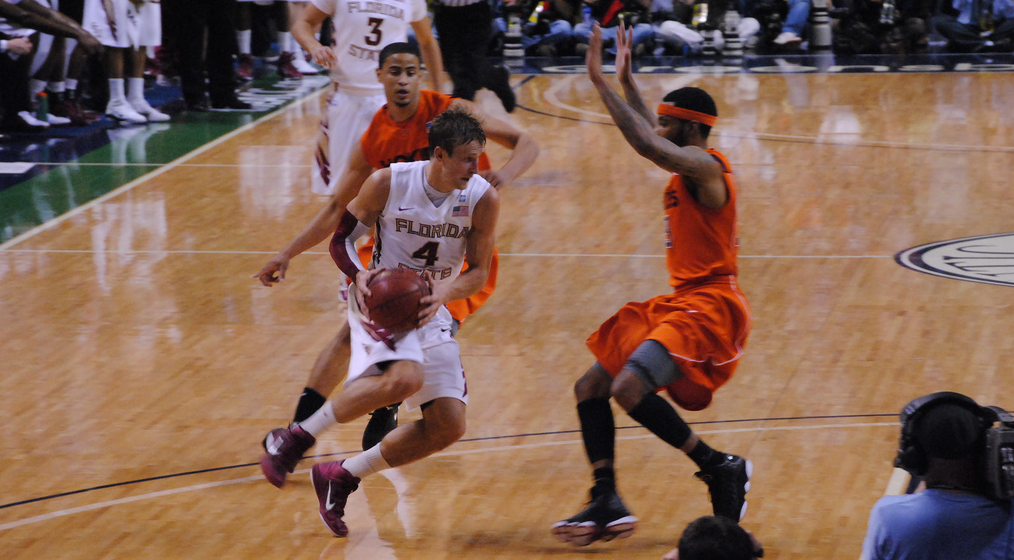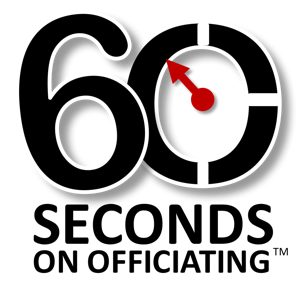
Photo courtesy of Garry Thompson.
The Shocking Truth About Continuous Motion
Are you too tight … or loose … when it comes to judging whether a player is in the act of shooting.
How often have you heard a crew member or yourself say … “On the floor” … after whistling a foul on a defender that is stopping an offense player’s drive to the basket. Unfortunately the concept of continuous motion gets a bit cloudy in the heat of battle. Here’s a few tips that might help you keep it straight in the future.
First of all, there is NO DIFFERENCE in the high school, college, or NBA rules regarding continuous motion.
How often do you hear from the stands … “Hey, it’s not the NBA out there” … as they think the officials are giving too much latitude around continuous motion.
But more often the problem lies in the “tighter” interpretation of the concept.
Obviously a player does not have to be airborne to be attempting a try for goal, so the extra verbiage of “on the floor” is superfluous at best and many times inaccurate. Pointing to the floor is an additional non-approved signal that really means nothing and should be put in your closet of “things not to use.”
Key tenets of the CONTINUOUS MOTION are:
- Continuous motion has no significance unless the foul is on the defense.
- There is a “window of time” that a defensive foul must occur for it to be considered in the act of shooting.
- The window opens when the try begins … and closes when the ball is in flight. These are two key elements to burn in your mind. Try begins and ball in flight.
So it’s pretty easy to know when the ball is in flight, so let’s concentrate on the part of the window that many officials seem to get confused on.
The try begins with:
- the habitual movement which usually precedes the shot.
- and this movement is the motion of the arms, legs, feet, or other body movement needed to complete the try for goal.
- This is commonly called, “in the act of shooting.”
Basically the continuous motion allowance this gives the shooter an opportunity to complete their original task of making the attempt for goal even with the defender putting them at a disadvantage through fouling.
Things to note, if the foul occurs during a TAP, the interval begins with the touching of the ball and end with the ball clearly in flight. This is much easier to see the window.
The offensive player (when fouled in the act of shooting) has the right to continue their try for goal.
If they are pivoting or stepping when fouled they may complete the usual foot (or body) movement which customarily precedes the release of the ball.
The shooter does NOT have to be in the final stages of a try … it must only have BEGUN.
This is where many of our well intention-ed officials put our shooters at a 2nd disadvantage, by ruling the foul occurring “before the try begun” … or in their words “on the floor.” These privileges are given only when the “usual” throwing motion has started before the foul occurs.
So in review …
- Motion – refers to the body movement of the player who has started the try for goal.
- Habitual body movement – is the movement which customarily precedes the shot.
- Continuous – refers to the right for an offensive player to continue their try for goal, when fouled by the defense.
A patient whistle and seeing the entire play through will reduce the tendency for good officials to make poor choices when it comes to ruling fouls as it relates to continuous motion.

Doesn’t continuous motion end when an airborne shooter returns to the floor? The article mentions it ends with the release of the ball but the offensive player is still in the shooting motion until they return to the floor. The way it is worded makes it sound as if a shooting foul cannot be called once the ball is released. Otherwise good article on a topic needing attention.
Just curious on what verbiage you would recommend to communicate that the player was not in the act of shooting if you have just a common foul. There are clearly times that the player gets fouled prior to going into the act of shooting and not to communicate that prior to going to the table to report the foul is like having a block/charge and not communicating what you have until you get to the table. To me a good example is a dribble drive where the dribbler gets bumped and quickly takes another dribble and then goes up for a try.
Solid article…may have wanted to address that CM ends immediately if a teammate commits a foul..also regarding the airborne shooter….the airborne shooter is defined in Rule 4 and stands by its own definition and has nothing to do with CM.
To Kyle
One quick and emphatic word can be used to indicate a common four. BEFORE. Emphetic use will show your decision is solid. I generally move to the spot of the foul yelling “before, before the shot”. Eliminating on the floor is a must as the article mentioned most every shot Begins on the floor prior to the shooter going airborne
Motion includes the initial hand movements from the side which indicates that that person is going to shoot. Too many times I see the person fouled on the arm as he attempts to start the motion upward and then have ref’s call on the floor. It’s a 2 shot foul not ball out of bounds.
On a dribble drive, one way to determine if the offensive player has started his shooting motion is if he has completed his dribble and has the ball in both hands. He is no longer dribbling so his motion (steps) is the habitual body movement which is part of his act of shooting. If he ends up passing the ball you have a common foul.
Bob … that’s an “awesome” guideline to follow when trying to determine if the shooting motion has started. I agree, if a player has completed their dribble, and has gathered their hands on the ball, this most likely is the “habitual body movement” we are looking for.
Great job of eliminating the “on the floor” concept, it is long overdue and rarely talked about. Unfortunately, the levels that our officials see on TV, NCAA Division 1 & NBA, do not provide good examples for both signals & rulings regarding this concept, therefore validating poor decision making.
What is the ruling if the player starts the try for goal, the push foul causes player to take an extra step, and then makes the basket?
My rebuttal to the above would be that the end of one motion does not constitute the beginning of another. Often the word “Gather” is utilized to decide a shooting (or non-shooting) foul. College books use ‘upward motion”. To me, the simple gathering of a ball is not necessarily the beginning of a shot. If he passes, obviously you don’t shoot FT’s but players are so smart these days that if you blow the whistle around the time of the gather, they are going to shoot when that was not their original intention. I saw it this weekend; BYU @ Gonzaga, an official used the “gather” principle, when Tyler Haws had ended his dribble, was fouled, and was at least two strides from making a lay-up attempt, and also which occurred about 3 ft inside the 3 point line. You can’t get me to buy that he had started any sort of shooting motion that far away from the hoop (it was a fast break) and that this was a shooting foul. There is nothing in either manual, high school or college, that uses gather. The words are “habitual shooting motion” and “upward motion”